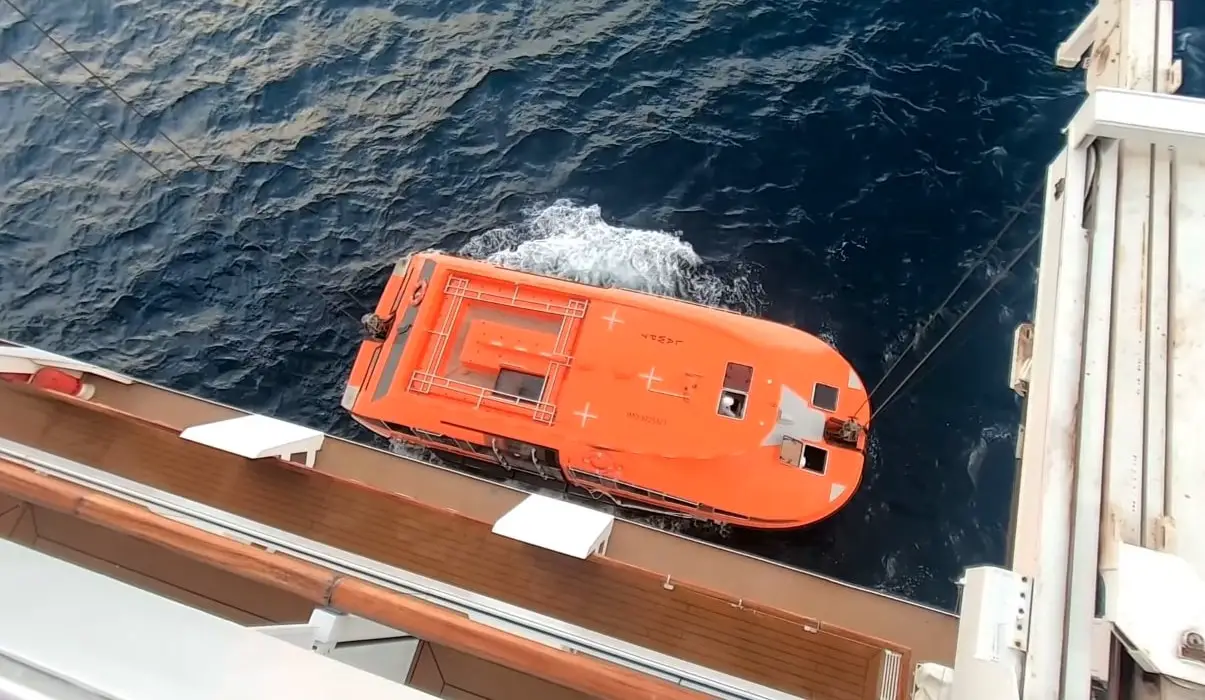If you’re planning a cruise trip, you may wonder if cruise ships have enough lifeboats for all passengers and crew in case of an emergency.
The answer is not a simple yes or no; rather, it depends on a few factors.
Do Cruise Ships Have Enough Lifeboats?
According to maritime safety regulations, cruise ships must have enough lifeboats and life rafts to accommodate at least 75% of the maximum capacity of people on board, including passengers and crew. The remaining 25% can be accommodated in life rafts.
Lifeboats that accommodate up to 37.5% of crew and passengers should be placed on either side. So, lifeboats to accommodate 70% of the total guests + crew is mandatory.
Now you may be wondering about the remaining 25 percent.
As per the maritime safety regulations, for the remaining 25 percent, there will be enough life rafts.
As per the guidelines of IMO, a cruise ship should have life rafts that could accommodate more than the remaining 25%.
How Many Lifeboats Are On A Cruise Ship?
The number of lifeboats on a cruise ship can vary greatly depending on the size and passenger capacity of the vessel. Here are some typical numbers of lifeboats:
- Small ships (up to 250 passengers): 2-4 lifeboats
- Mid-size ships (250-1000 passengers): 6-8 lifeboats
- Large ships (1000-4000 passengers): 8-16 lifeboats
- World’s largest ships (5000+ passengers): 20+ lifeboats
In addition to lifeboats, cruise ships have numerous inflatable life rafts that can be quickly deployed in an emergency.
Some examples of lifeboat numbers on real cruise ships:
- Carnival Vista (4000 passengers): 20 lifeboats
- Royal Caribbean Oasis of the Seas (6000 passengers): 18 mega lifeboats
- Norwegian Bliss (4000 passengers): 16 lifeboats
- Disney Fantasy (4000 passengers): 14 lifeboats
The total lifeboat capacity should be at least 75% of the total guests + crew count.
The number, size, and capacity of lifeboats are determined by international maritime regulations and the ship’s dimensions and layout.
Cruise lines work closely with regulators to ensure each new ship meets or exceeds the latest safety standards.
How Many People Can Fit In a Cruise Ship Lifeboat?
When it comes to cruise ship safety, lifeboats are an essential part of the equation. But how many people can fit in a lifeboat?
According to the LSA Code, most cruise lines use lifeboats designed to accommodate the maximum possible number of people. This means that the number of people who can fit in a lifeboat will depend on size.
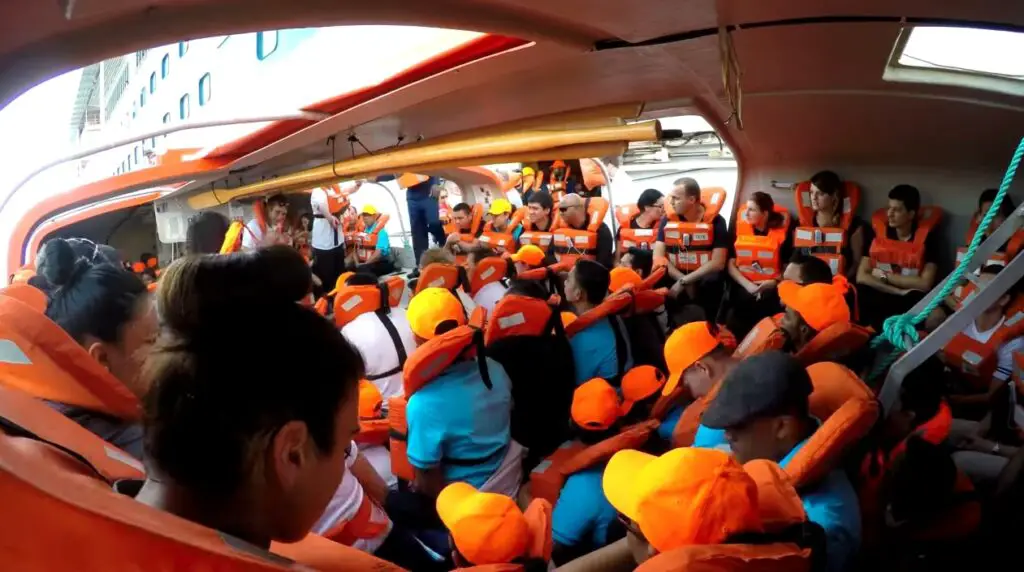
The number of people each lifeboat can hold varies by cruise line and specific boat model. But most cruise ship lifeboats have a capacity of between 150 to over 300 people.
Lifeboats are configured with extended bench seating and have low ceilings to accommodate as many passengers as possible.
For example, Royal Caribbean’s lifeboats have a capacity of 155 to 370 people. So on a ship like Symphony of the Seas with 18 boats, the total lifeboat capacity is around 6,660 people. This helps provide emergency evacuation for most of the ship’s total passengers and crew.
Life Rafts Vs. Life Boats
What’s the difference between lifeboats and life rafts on cruise ships? And why do ships have both?
Lifeboats
Lifeboats are hard-shell boats with enclosed cabins that can be launched and operated independently of the ship.
They contain supplies, an engine, navigation equipment, and sometimes basic facilities like water and bathrooms.
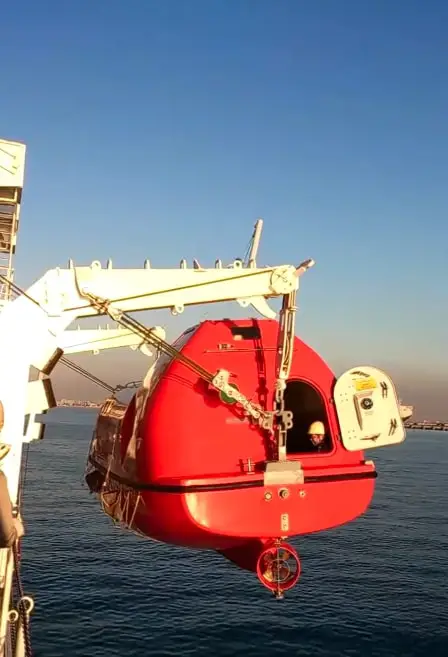
Lifeboats allow passengers to evacuate the cruise ship and get fully clear of any hazards while waiting for rescue.
Life rafts
Life rafts are lighter inflatable crafts without engines. They require launching equipment and lines to lower them into the water from the cruise ship.
Rafts are temporary habitats until passengers can transfer to lifeboats or be rescued. Due to their small storage footprint, inflatable rafts maximize survival craft capacity on board cruise ships.
Having lifeboats and rafts provides cruise ships with versatile, redundant survival capacity tailored for different emergencies.
Lifeboats allow immediate evacuation and complete separation from the ship. Life rafts offer accessible capacity for more passengers during a rapid evacuation.
What is The Requirement for Lifeboats on a Cruise Ship?
To sail legally, cruise ships must meet specific safety requirements for lifeboats mandated by international maritime regulations.
The primary guideline is the International Convention for the Safety of Life at Sea (SOLAS) overseen by the International Maritime Organization.
Under SOLAS, cruise ships must carry enough lifeboats to accommodate at least 37.5% of the total number of people on board.
So on a ship with 4,000 passengers and crew, for example, lifeboat capacity must be for at least 1,500 people.
Ships built or converted after 1986 are required to accommodate at least 75% of people on board between lifeboats and life rafts combined. So modern cruise ships’ total survival craft capacity is greater than the pure lifeboat requirement.
These SOLAS lifeboat requirements provide an important emergency evacuation minimum for the massive populations onboard cruise ships. But as we’ll see next, some industry experts argue even more capacity is needed.
How Many Lifeboats Are Needed on a Cruise Ship?
Do current regulations requiring enough lifeboats for 37.5-75% of passengers provide adequate safety?
According to some maritime safety advocates, cruise ships should have enough lifeboats for 100% or more of the people on board.
The reasoning is straightforward – during an emergency evacuation like a sinking, having the capacity to get every single person safely off the ship as quickly as possible should be the goal.
Partial coverage leaves the risk of some passengers being left behind if total evacuation is needed.
But cruise lines argue that having lifeboats for 100% or more of passengers is unrealistic. Modern cruise ships already dedicate large amounts of deck space to existing boats and rafts.
Fitting enough to accommodate all passengers would require nearly the entire outer deck, leaving little room for pools, lounges, and other amenities that guests expect.
Where are the lifeboats on a cruise ship?
On cruise ships, lifeboats are mounted on davits or mechanical arms on open decks for quick deployment.
Typically, lifeboats are located on upper decks near lifevest stations and embarkation areas. This allows easy access for passengers during an emergency evacuation.
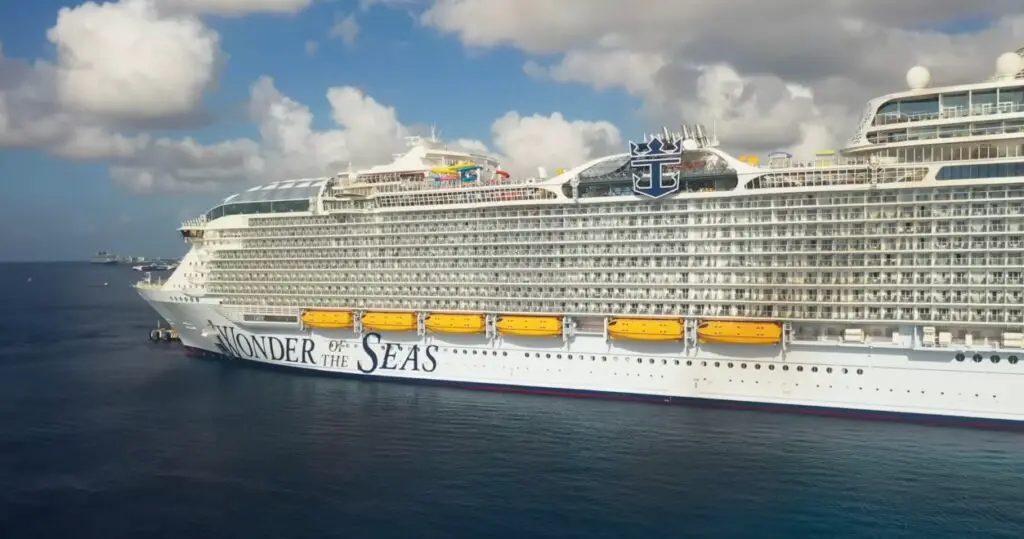
You can identify lifeboat locations on a cruise ship by color-coding and numbering. The boats are usually painted bright orange, and each boat will have a visible number displayed on both sides of the bow.
Lifeboats are positioned on the ship’s outer port and starboard sides for maximum launching stability.
Usually, boats are spaced evenly apart from each other along the length of the deck. On larger ships, lifeboats may be located on multiple available outer decks to provide capacity for more passengers.
Next time you take a cruise, check out a deck plan to see where lifeboats are located. Look for bright orange boats aligned along open areas of the outer decks. Knowing how to find lifeboats can help you get oriented in an emergency.
Do cruise ship lifeboats have engines?
Yes, cruise ship lifeboats are equipped with inboard diesel engines to provide self-powered propulsion. Having independent powered engines allows lifeboats to rapidly move away and maneuver independently from the cruise ship after being launched.
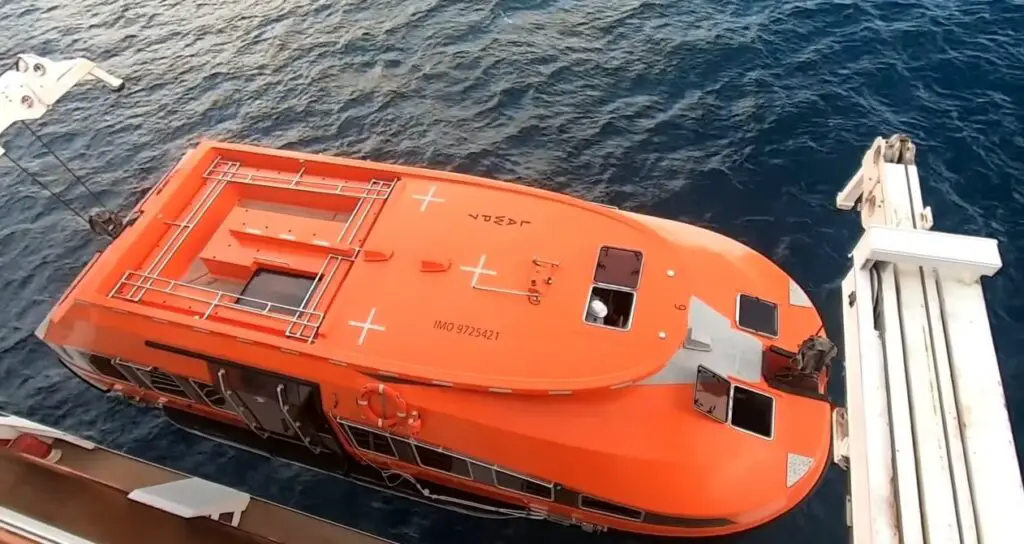
Lifeboat engines are typically at least 30-50 horsepower. The engine power can reach up to 115 HP on some larger lifeboats. Powerful engines ensure lifeboats can overcome wind and waves to evacuate even under poor sea conditions successfully.
In addition to the main drive engine, lifeboats also have a smaller generator engine. This provides power for electrical systems like radios, lighting, ventilation fans, and water pumps.
Cruise ship crew members are trained to maintain lifeboat engines and test them regularly. The engines need to be ready to start instantly and operate reliably in an emergency to deliver passengers to safety.
With robust powerplants, lifeboats provide crucial escape mobility if a cruise ship is endangered.
Is there food on a lifeboat?
Lifeboats on cruise ships contain emergency provisions to sustain passengers while awaiting rescue.
According to maritime safety requirements, each lifeboat must carry fresh water and 7 days of food rations for the maximum number of people on board.
Typical lifeboat food rations include high-calorie survival items like dried biscuits, energy bars, crackers, tinned fish, meat, and fruits. Drinking water is stored in sealed containers.
Lifeboat food supplies provide critical nourishment during an emergency evacuation at sea when quick rescue is not guaranteed.
In addition to food and water, lifeboats also contain basic emergency equipment. This includes first aid kits, signal flares, flashlights, whistles, thermal blankets, rain gear, seasickness medication, and sanitation/hygiene supplies.
While no one hopes to ever rely on lifeboat rations, it’s reassuring to know cruise ship lifeboats are stocked with essentials to aid survival for multiple days if needed.
Do cruise ship lifeboats have toilets?
Typically, lifeboats on cruise ships do not have integrated toilet facilities. Using the restroom is one of the more challenging realities if passengers end up needing lifeboat evacuation for an extended time.
However, some larger lifeboats are designed with small privacy curtains and basic portable toilet buckets. This allows for makeshift human waste management without an installed marine head.
For the majority of lifeboats without curtains or pails, passengers would be limited to urinating over the side or into a container if stuck for prolonged hours or days. For solid waste, passengers may need to uncomfortably do their best given the demands of the situation. It’s not a pleasant thought but a likely necessity until rescue.
While the lack of bathrooms is not ideal, including fully plumbed heads and holding tanks on lifeboats would reduce maximum passenger capacity. Tradeoffs exist between comforts and saving space for people in life-or-death evacuations. Preparing mentally and emotionally is part of cruise ship safety.
Did the Titanic have enough lifeboats?
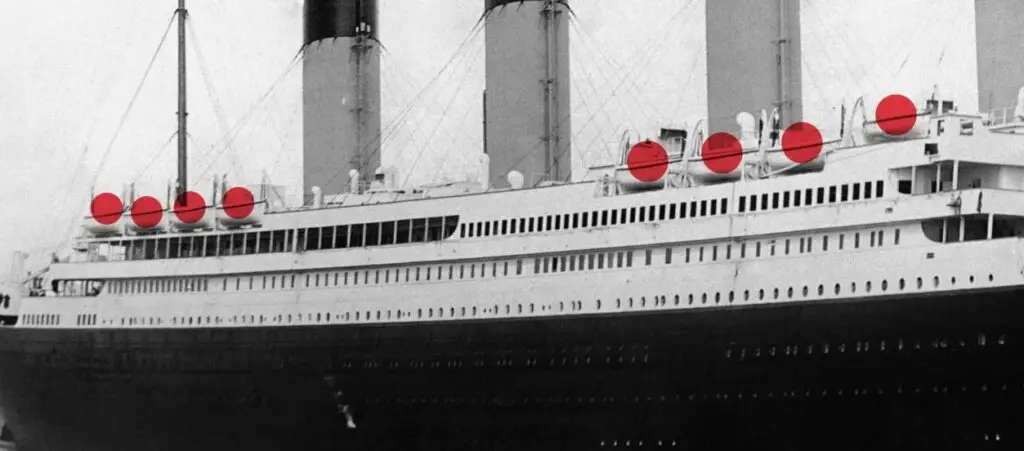
When the Titanic sank in 1912, there were only 20 lifeboats onboard for the over 2,200 passengers and crew. This was fully compliant with maritime regulations of the time, which dictated having a lifeboat capacity for about 1/3 of those on board.
20 lifeboats on the Titanic only had a capacity of 1178 people.
But when Titanic hit the iceberg and call went out to abandon ship, there was only enough space in the boats for around half of the passengers. Regrettably, over 1,500 people were left behind on the Titanic as it sank, resulting in a huge loss of life due to insufficient lifeboats.
The sinking of Titanic sparked revisions to maritime safety laws regarding lifeboat capacity. New standards mandated enough lifeboats for at least 75% of passengers and crew in addition to life rafts
Had these updated regulations been in place earlier, many more lives could potentially have been saved on the Titanic.
Frequently Asked Questions
Can lifeboats be lowered safely if the cruise ship is tilting or sinking?
Cruise ship lifeboats are designed to be launched even if the vessel is listing up to 20 degrees. If needed during extreme tilting, lifeboats on the raised side can be moved via onboard davits to the lowered side for easier launching. Lifeboats can also detach completely from the sinking ship to get clear.
How are passengers assigned to lifeboats in an evacuation?
Responsible crew members oversee loading passengers into lifeboats according to carefully planned procedures. The priority is getting boats lowered and away from the ship safely as quickly as possible. Passengers should follow crew instructions for orderly boarding and launching.
Can passengers try getting in a lifeboat if they think the ship is sinking?
Passengers should never try to board lifeboats on their own except by direct orders from the captain and crew during an evacuation. Lifeboats require proper preparation and procedures for safe loading and lowering. Attempting to take matters into your own hands can make the situation more dangerous for everyone.
Wrap Up
Cruise ships take extensive precautions to keep passengers safe, including carrying lifeboats and life rafts.
While regulations don’t require enough emergency boats for 100% of people on board, crews are extensively trained on emergency evacuations. The probability of needing full abandonment is extremely low.
But if the worst happens, cruise lines work hard to ensure they have life-saving capacity and procedures to maximize lives saved.
Though more capacity is always better, cruise lines must find a reasonable balance across safety, regulations, costs, and customer experience.
With sound design and training, crews can successfully evacuate passengers from even the largest ships using on-board lifeboats.

